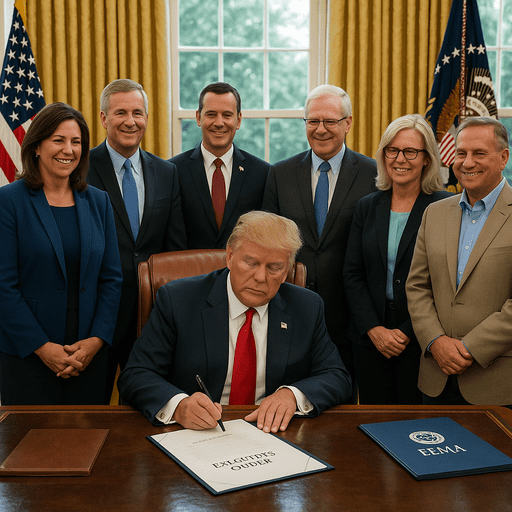In a decisive move to enhance the nation’s disaster preparedness, President Donald Trump has signed an executive order transferring the responsibility for disaster preparations from the Federal Emergency Management Agency (FEMA) to state and local governments. This strategic shift underscores the administration’s commitment to empowering local authorities, who possess intimate knowledge of their communities’ unique needs and challenges.
The executive order establishes the National Resilience Strategy, a comprehensive framework designed to assess risks to critical national infrastructure and streamline federal-state collaborations. By prioritizing “common sense” investments, the strategy aims to bolster national security against a spectrum of threats, including wildfires, hurricanes, and cyber-attacks. Notably, the order does not specify particular measures or funding sources, allowing for flexibility in implementation.
This policy realignment is a practical response to longstanding critiques of FEMA’s centralized approach. Historically, the agency has faced challenges in delivering timely and efficient aid during disasters. For instance, a Department of Homeland Security Inspector General report highlighted FEMA’s mismanagement of nearly $10 billion in COVID-19 relief grants, raising concerns about the agency’s capacity to handle future emergencies. By decentralizing disaster preparedness, the administration seeks to mitigate such inefficiencies.
However, the transition places significant demands on state and local governments. While these entities are well-positioned to tailor responses to their specific contexts, they may encounter resource constraints and varying levels of preparedness. The shift necessitates substantial investment in local infrastructure and training to ensure readiness for large-scale disasters.
The policy also prompts a reevaluation of funding mechanisms. Traditionally, FEMA has been the primary conduit for federal disaster relief funds. With the new directive, states and localities will need to establish robust financial frameworks to manage and allocate resources effectively. This change may lead to disparities in disaster preparedness and response capabilities across different regions, depending on their fiscal health and administrative capacity.
Critics have expressed concerns about the potential for reduced federal oversight and support. They argue that while local empowerment is beneficial, the federal government plays a crucial role in coordinating large-scale disaster responses and providing resources that may be beyond the reach of individual states. The absence of detailed guidelines in the executive order further fuels apprehension about the consistency and effectiveness of disaster preparedness nationwide.
Despite these challenges, the administration remains confident that the shift will lead to more responsive and efficient disaster management. By entrusting local authorities with greater responsibility, the policy aims to foster innovation and adaptability in disaster preparedness strategies. The success of this approach will depend on the development of clear protocols, adequate funding, and ongoing collaboration between federal and local entities.
As the nation adapts to this new paradigm, it is essential to monitor the implementation process closely. Identifying and addressing any emerging issues promptly will be crucial to ensuring that the policy achieves its intended outcomes. With time, sufficient staffing, and continued refinement, the system is expected to evolve into a more effective and resilient framework for disaster preparedness.
—
Deborah Cole reports on climate regulations, environmental mandates, and disaster response. She holds a degree in environmental studies from the University of Florida and worked in state-level emergency management before joining the press. Her reporting follows how policy meets practice across agencies, municipalities, and emergency zones.



